|
|
|
Sort Order |
|
|
|
Items / Page
|
|
|
|
|
|
|
| Srl | Item |
| 1 |
ID:
155747
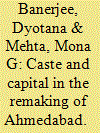

|
|
|
|
|
| Summary/Abstract |
The city has been eulogized as a liberating space of anonymity where identities of caste and creed dissolve before the might of economic capital. This paper examines how the role of caste is both masked and intensified in the formation of new neighbourhoods in the backdrop of city-remaking projects. Our ethnographic study of Dalit-dominated neighbourhoods in Ahmedabad shows that the emergence of a middle-class neighbourhood in Ahmedabad’s periphery must be seen as a ‘post-liberalization Dalit ghetto’ that is distinct from the pre-liberalization Dalit neighbourhoods in the industrial centre of the city. The new Dalit middle-class neighbourhood of Chandkheda is a result of greater economic mobility among Dalits which continues to be marked by the three exclusionary mechanisms: ‘moving up’ and into segregation; caste vigilantism; and protean forms of intra-Dalit exclusion. The collusion of caste and capital produces unexpected forms of space politics that tend to enhance rather than dissolve distinctions based on micro-caste identities in middle-class residential spaces, all the while hiding new forms of exclusion behind the rhetoric of secularized urban development.
|
|
|
|
|
|
|
|
|
|
|
|
|
|
|
|
| 2 |
ID:
155745
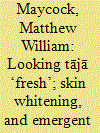

|
|
|
|
|
| Summary/Abstract |
Throughout the Indian subcontinent there is a broad range of skin-whitening products (SWPs) widely advertised on TV, cinema on the streets etc … . In recent years, the multinational companies who produce these products have begun to focus on an untapped market – men and boys. Complementing feminist insights relating to the ways in which ‘body work’ is a form of control over women and constitutes a means of maintaining gender hierarchies, this paper considers the implications for men of a specific manifestation of ‘body work’, in this instance the use of SWPs. Based on the analysis of the ways that a group of young Nepali men talked about these products, this paper considers the evolving use of the Nepali word tājā (adj; fresh). Ultimately, this paper considers what are the consequences of the consumption of SWPs for local manifestations of embodied masculinities in far-west Nepal.
|
|
|
|
|
|
|
|
|
|
|
|
|
|
|
|
| 3 |
ID:
155743
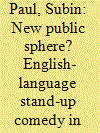

|
|
|
|
|
| Summary/Abstract |
The genre of English-language stand-up comedy is increasingly becoming popular in India’s metropolitan cities. This study uses the concept of the public sphere to examine YouTube videos of a prominent Indian live comedian, Daniel Fernandes. The analysis shows that Fernandes’ verbal humor is based on several performative techniques such as linguistic code-switching, calculative pauses, and juxtaposition of incongruous things. The study, furthermore, demonstrates that English-language stand-up comedy extends the bourgeois public sphere by a satirical commentary on political, social, and cultural issues in contemporary India as well as internationally. The article also argues that the public sphere exemplified by the genre of English-language live comedy is not entirely new, but an advancement of the classical public sphere.
|
|
|
|
|
|
|
|
|
|
|
|
|
|
|
|
| 4 |
ID:
155746
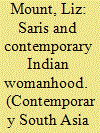

|
|
|
|
|
| Summary/Abstract |
Despite the major changes in urban middle-class Indian women’s clothing in the past 30 years, there are few accounts of women’s perspectives on their changing dress. This paper analyzes 31 semi-structured interviews with urban middle-class women in Delhi, Mumbai, and Pune to examine the changing meanings associated with saris in contemporary India. While the sari has entered the realm of global fashion and can thus be characterized as modern and sexy, the garment remains strongly associated with respect and maturity for women, particularly within their families, but also in public spaces and in the workplace. Women link their practices of sari wearing to modern aspirations by emphasizing saris as ‘modern’ fashionable attire, while simultaneously reinforcing the sari as a symbol of traditional, respectable married womanhood, thus exploiting the traditional meanings that the sari confers on them to their advantage. The emphasis on saris as simultaneously ‘modern’ and representative of Indian tradition indicates the cultural pressure placed on middle-class women to conform to dictates of traditional womanhood while also aligning themselves with modernity.
|
|
|
|
|
|
|
|
|
|
|
|
|
|
|
|
| 5 |
ID:
155748


|
|
|
|
|
| Summary/Abstract |
Headaches, infertility and cancer are some of the health hazards most commonly associated with exposure to the electromagnetic fields (EMF) generated by mobile handsets and base transceiver stations. In contemporary India, home to the world’s second biggest market of mobile phone users, the impact of EMF on health has attracted a considerable degree of attention in recent years, leading to debates between citizen lobby groups, central and municipal authorities, telecommunication companies, medical practitioners and scientists. This essay discusses anti-tower activism in urban India and the government’s response to it, aiming to understand how online newspapers and magazines report on this topic and how concerned citizens use various media platforms to challenge government policies around telecom towers. It argues that interpreting anti-tower protests simply as the result of fear-mongering by the media or uninformed citizens overlooks the ways in which campaigners strategically employ discourses about health hazards, in particular the scientific uncertainty surrounding the impact of EMF on health, to protest against the haphazard proliferation of towers and to voice their discontent with the state’s failure to regulate and control the telecom industry.
|
|
|
|
|
|
|
|
|
|
|
|
|
|
|
|
| 6 |
ID:
155744
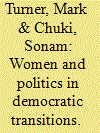

|
|
|
|
|
| Summary/Abstract |
This article addresses the question of what happens to women in democratic transitions. Of particular concern is whether women are encouraged to participate in politics and to stand as candidates for seats in national legislatures. In many instances, women have made only marginal progress in seeking election and getting elected in newly democratized regimes. This situation has been the experience of Bhutan, a country that held its first national elections only in 2007–2008. Despite women making significant gains in areas such as education, health and employment in Bhutan and guarantees of gender equality in the Constitution, they have made a poor showing in electoral politics. The article uses the explanatory framework of patriarchy to explore women’s minor participation in electoral politics. Of special concern are deeply rooted traditional concepts that have been employed today to exclude women from competing for and winning political office. The article concludes that because patriarchal attitudes are so deeply embedded only incremental progress will be made under current electoral rules. Alternatively, there could be quota systems as in some other South Asian countries.
|
|
|
|
|
|
|
|
|
|
|
|
|
|
|
|
|
|
|
|
|